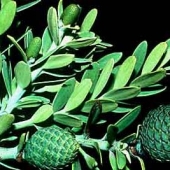Please select root levels for the menu
NZ Plants
Dacrycarpus dacrydioides - kahikatea, white pine
Podocarp family: Podocarpaceae
-
Mature foliage
L Jensen
View picture -
Mature foliage, leaf detail
I MacDonald
View picture -
Juvenile foliage
L Jensen
View picture -
Juvenile foliage, leaf detail
I MacDonald
View picture -
Near-mature leaves
L Jensen
View picture -
Pollen cones
L Jensen
View picture -
Pollen cone scales
L Jensen
View picture -
Ovule cone at time of pollination, fertile scale and ovule (left)
L Jensen
View picture -
Fertile scale partially covering the inverted ovule and micropyle pore, side view
L Jensen
View picture -
Ovule covering (epimatium) with micropyle pore, face view.
L Jensen
View picture -
Post-pollination ovule cone, fertile scale begining to grow over the ovule
L Jensen
View picture -
Developing seed
L Jensen
View picture -
Maturing seed cone
L Jensen
View picture
Dacrycarpus dacrydioides is New Zealand’s tallest forest tree. Adult trees have dull green overlapping scale leaves while juvenile trees have needle-like leaves often with a bronze hue. Small, fleshy, one-seeded ovule cones are formed in which the ovule is covered with both an inner integument and an outer epimatium (derived from the seed scale). After fertisation the fused bases of the bracts below the cone enlarge into a fleshy receptacle.
An endemic species found throughout New Zealand favouring moist to swampy areas.
A small genus with one species in New Zealand and eight species found in Fiji, Southeast Asia and China.
More on kahikatea: Takana Newsletter
Vegetative characteristics |
Reproductive characteristics |
|---|---|
Adult plant form: tree up to 65 m |
Pollen and ovule cones: on separate trees |
Adult leaf form: linear, awl-shaped (concave inner surface) |
Pollen cone: 5- 10 mm long, 30-40 scales |
Adult leaf size: 1-2 mm long |
Ovule cone: 60-120 mm long with 2-3 bracts, one of which bears a fertile cone scale with a single ovule on the upper face |
Adult leaf arrangement: spiral, flattened (appressed) to stem |
Ovule cone position: terminal on short stem |
Juvenile leaf form: linear, narrow |
Ovule coverings: an inner covering (integument); an outer covering (epimatium) covers the entire ovule; basal bract becomes fused to one side of ovule |
Juvenile leaf size: 3-7 mm long |
Ovule pore (micropyle): directed downward |
Juvenile leaf arrangement: flattened in two rows, spreading from the stem |
Mature seed cone: fleshy, 8-10 mm long; single seed |
Stem(receptacle) below seed: fleshy, derived from basal bracts; red, yellow |




